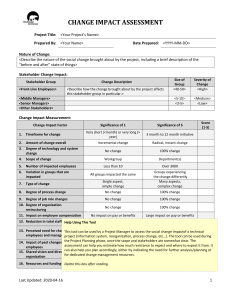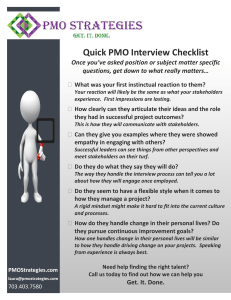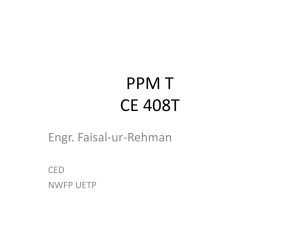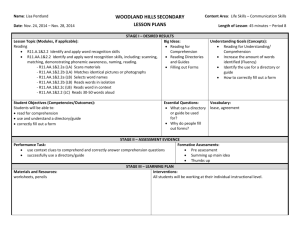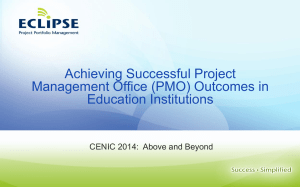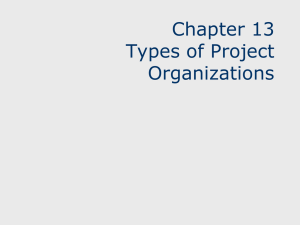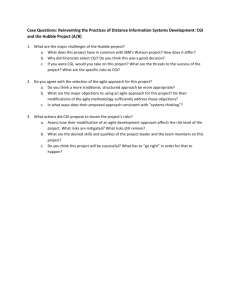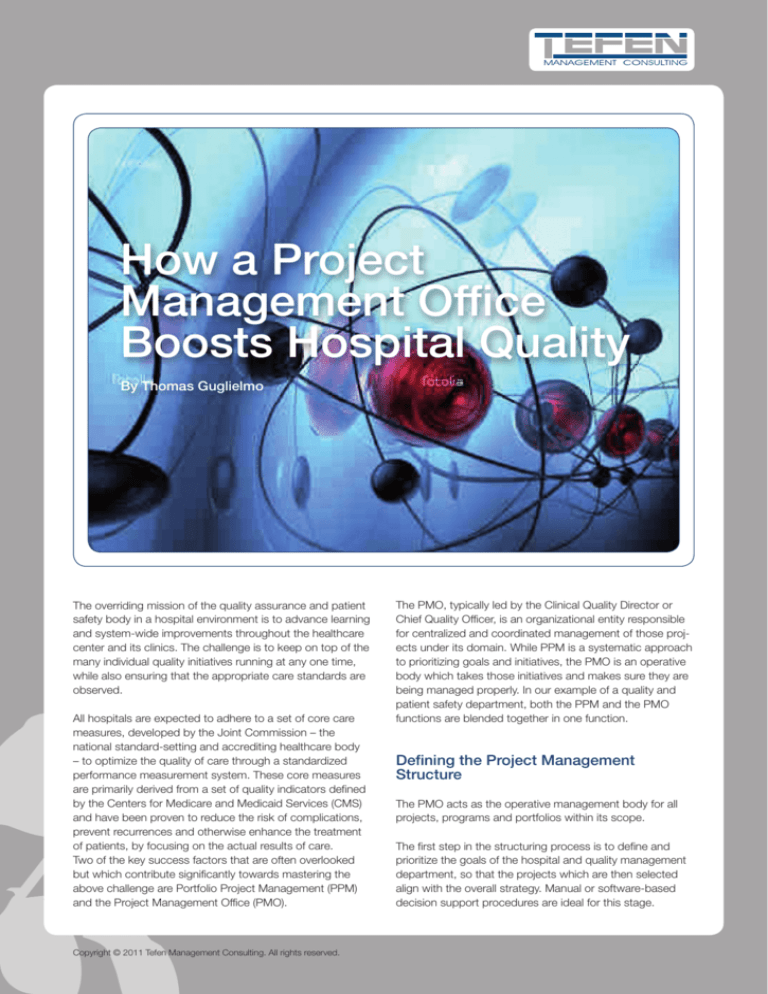
How a Project
Management Office
Boosts Hospital Quality
By Thomas Guglielmo
The overriding mission of the quality assurance and patient
safety body in a hospital environment is to advance learning
and system-wide improvements throughout the healthcare
center and its clinics. The challenge is to keep on top of the
many individual quality initiatives running at any one time,
while also ensuring that the appropriate care standards are
observed.
All hospitals are expected to adhere to a set of core care
measures, developed by the Joint Commission – the
national standard-setting and accrediting healthcare body
– to optimize the quality of care through a standardized
performance measurement system. These core measures
are primarily derived from a set of quality indicators defined
by the Centers for Medicare and Medicaid Services (CMS)
and have been proven to reduce the risk of complications,
prevent recurrences and otherwise enhance the treatment
of patients, by focusing on the actual results of care.
Two of the key success factors that are often overlooked
but which contribute significantly towards mastering the
above challenge are Portfolio Project Management (PPM)
and the Project Management Office (PMO).
Copyright © 2011 Tefen Management Consulting. All rights reserved.
The PMO, typically led by the Clinical Quality Director or
Chief Quality Officer, is an organizational entity responsible
for centralized and coordinated management of those projects under its domain. While PPM is a systematic approach
to prioritizing goals and initiatives, the PMO is an operative
body which takes those initiatives and makes sure they are
being managed properly. In our example of a quality and
patient safety department, both the PPM and the PMO
functions are blended together in one function.
Defining the Project Management
Structure
The PMO acts as the operative management body for all
projects, programs and portfolios within its scope.
The first step in the structuring process is to define and
prioritize the goals of the hospital and quality management
department, so that the projects which are then selected
align with the overall strategy. Manual or software-based
decision support procedures are ideal for this stage.
possible by individual project management. Programs may
also include elements of related work outside the scope of
the specific projects in the program. Finally, a portfolio describes a collection of programs, projects and other works
that are grouped together to facilitate effective management
of the work entailed in order to meet strategic business
objectives. The projects or program in the portfolio may not
necessarily be interdependent or directly related.
Roles involved
Portfolio
level
Main responsibilities
Structure
Quality Committee
Steering Members
Portfolio Managers
Cross-functional portfolio management and
Steering Committee
Management of portfolio
Program
level
The second step involves defining what constitutes a project, how projects interrelate into a program and then identifying how these programs pursue clearly outlined portfolio
objectives i.e. the main priorities of the hospital. A project
can be explained as a temporary endeavor undertaken to
create a unique product, service or result, over a specified time period. A program is a group of related projects
coordinated to obtain benefits and a level of control not
Program Steering Group
Executive Sponsor
Program Managers
Chair Program Steering Group
Management of program to deliver benefits
Project level
Project Steering Group
Project Managers
Overall responsibility for successful planning,
execution, monitoring, control and closure of project
Achieve results specified in project charter
Provide regular updates to PMO
Project Leads
Responsible for leading a specific project workstream
and reporting to the Project Manager
Project
Sub Project
Sub Project
The type of PMO design used for a certain healthcare
center depends on the portfolio complexity, competency
of project managers and maturity of each program and
project. There are 3 distinct PMO models and the aim is to
focus on that which meshes best with your organization.
A strategic PMO is best suited for a large-scale organization
taking on many different projects and needing a stronger
PMO for
Program
X
centralized force. The service model calls on PMO resources and tools to take on the project management aspect of
each project. The functional model focuses on getting projects to a “functional” level. In this case, the PMO provides
the methodology and a high presence during initiation and
planning but its involvement drops during execution.
Strategic
Service
CPMO
PMO Leader
Methodology,
Prioritization,
Portfolio
PMO Leader
Methodology,
Data for Decision
Making
PMO for
Program
Y
PMO for
Program
Z
Project managers are responsible for
PM implementation
PMO supports and monitors project
managers
CPMO responsible for projects initiation,
prioritization, portfolio management
Functional
Initiation
PMO Leader
Methodology,
Integration
Monitor &
Control
Portfolio
Planner
Planner
Planner
PMO responsible for PM implementation,
with PMs support
PMO collects data for decision making
PMO implements the methodology
decided upon
Copyright © 2011 Tefen Management Consulting. All rights reserved.
“Functionally” focused
Create PMO expertise
Relevant mainly for “set-up” phase
The Project Lifecycle and Tools
The PMO’s involvement at the project level will be framed
around the project lifecycle. The major categories usually
inherent in a lifecycle include the initiation phase, planning,
executing and controlling and, finally, the closing phase.
Depending on the ambitions of your organization, it may
also make sense to add in an opportunity identification
phase. Once you have set up the project chronology and
timeline through a lifecycle, it is essential to define the
activities, deliverables, and decisions that occur at each
phase. These activities will build your process while the
deliverables will be the tools that support the activities.
Initiation phase – The essential tool at this stage of the
project is the project charter. The charter should define
the project at a high level and include the following
components:
Problem statement
Project objectives
Project goals
Team leads and members
Expected benefits
Constraints
Dependencies
specific timeframes. In addition the work plan will list the
individuals or teams responsible for each task. Another
important tool is the risk register. Mitigating risks is an important responsibility of the project manager and the whole
team should support it by pointing out possible barriers to
the project.
Execution phase – plans remain merely good intentions
unless they rapidly translate into hard work. The execu
tion phase is when the project team begins to realize
the initiatives and tasks set out in the work plan. Clear
communication and coordination are essential. At this
stage, the PMO is responsible for getting the project
moving and tracking implementation. This phase has
many parallels with the monitoring stage and involves
keeping a close eye on all issues and risks. To accom
plish this in an efficient manner, the project manager
and PMO will set up regular meetings, usually every fortnight, to review the work plan throughout the duration
of the project. Issues which cannot be resolved during
this meeting will be elevated to a senior level committee.
The main tools used during this phase are issue logs and
meeting minutes.
Planning phase – Planning is more than just listing out
the tasks of a project. It is critical that the project
manager answers the following questions when
planning the project.
What is the expected project outcome?
How will the work be done?
What do you expect of the project team members?
Who reports to whom?
When will the work be performed?
Are there any costs associated with the work?
Who will be affected by the change?
When will the team meet?
Who is required to attend the meetings?
How will minutes be recorded?
The work plan is the primary tool that the project manager
should use during this phase. The “perfect” work plan will
include all project related tasks and key milestones with
Opportunity
Identification
Why sould this opportunity
become a project?
Initiation
Project Charter
Team Identified
Planning
Work Plan
Financial Estimates
KPI’s
Copyright © 2011 Tefen Management Consulting. All rights reserved.
Monitoring and controlling phase – during execution of
the project, it is critical to monitor the Key Performance
Indicators (KPIs). Each KPI should have a target established and be measured on a weekly basis. KPIs are
typically managed through dashboards which help visu
alize project progress and keep track of goals, budget,
and schedule. Dashboards can be developed using business intelligence software or through Microsoft Excel.
Closing phase – a project is complete when it starts
working for you, rather than you working for it. Once a
project is closed there are a number of activities that
can be considered. The first activity should be to review
project performance and discuss lessons learned. In
addition, the project manager should consider archiving
project files in a centralized database so that materials
can be easily accessed for future projects. Finally the
team itself should receive recognition and celebrate
its achievements!
Executing
Updated Work Plans
Actual vs. Target Benefits
Project Status Updates
Closing & Continous
Improvement
Updated Work Plans
Actual vs. Target Benefits
Project Status Updates
Project KPI Dashboard: Motality Index
Project Name
Project Manager Due Date On Schedule Metric: Target Metric Current Life Cycle Phase Upcoming Milestone
PORTFOLIO: MORTALITY INDEX
DEPARTMENT: Medicine
SECTION
GENERAL MEDICINE
HOSPITALIST
CARDIOLOGY
HEMATOLOGY / ONCOLOGY
DEPARTMENT: Surgery
SECTION
BURN TRAUMA CRITICAL CARE
ENDOCRINE & SURGICAL ONCOLOGY
VASCULAR SURGERY
SURGICAL TRANSPLANTATION
CVTS
NEUROSURGERY
OPHTHALMOLOGY
ORAL SURGERY
ORTHOPAEDICS & ORTHO PODIATRY
OTOLARYNGOLOGY
PLASTIC SURGERY
UROLOGY
DEPARTMENT: Pediatrics
SECTION
DEPARTMENT: OB / GYN
SECTION
OB
GYNECOLOGY
GYNECOLOGICAL ONCOLOGY
YELLOW
Next Upcoming Milestone
High probability of not reaching next milestone
Medium probability of not reaching next milestone
Low probability of not reaching next milestone
GREEN
On Schedule
RED
Legend
GENERAL
MEDICINE
INITIATION
PLANNING
EXECUTION
MONITORING &
CONTROLLING
CLOSING
Life Cycle Phase
Conclusion
A study conducted by the Project Management Institute
revealed that more than 90% of projects fail to meet their
objectives. Applying the tools and methodologies discussed
above within a hospital’s quality department will generate
far reaching and multi-dimensional benefits. The PMO and
its processes help prevent the variability of the past and
create standardization across projects, increasing the overall success rate.
Thomas Guglielmo, Partner, Tefen USA
Copyright © 2011 Tefen Management Consulting. All rights reserved.
On Schedule
> 2 weeks behind schedule
< 2 weeks behind schedule
on schedule
Project Life Cycle
INITIATING (I); PLANNING (P); EXECUTING (E);
MONITORING & CONTROLLING (M & C)


